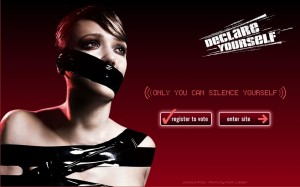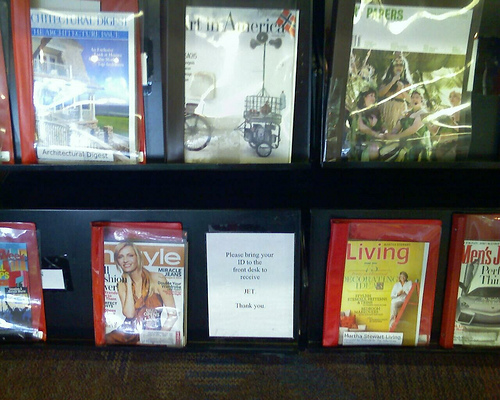Click here if this second video doesn’t come up.
NEW! Bumpersticker for sale at CafePress:
The “war on drugs” that began in the 80s led to a dramatic increase in the number of Black, but not so much White americans in prison and jail (see here). One of the consequences of disproportionately imprisoning Blacks and Latinos, of course, is disproportionately separating Black and Latino children from their parents.
 Source: Bureau of Justice statistics via Chris Uggen’s Weblog.
Source: Bureau of Justice statistics via Chris Uggen’s Weblog.
Kay W. took these images in a museum in Sitka, Alaska. This is David P. Howard, an Alaskan Native, and his family in 1917 (or so). Notice how Howard and his family appear to have shed every possible sign of “native-ness” in this picture. The conquest of American Indians was achieved, in part, through forced and coerced assimilation (see this post on American Indian boarding schools in Canada).
The family had to appear assimilated because Howard was seeking U.S. citizenship and citizenship was contingent on Howard abandoning his “Indian” ways. The document below testifies to Howard’s assimilation. The last paragraph reads:
NOW, THEREFORE, THIS IS TO CERTIFY that due proof has been made to me that the applicant David P. Howard is an Indian born within the Territorial limits of the United States, and that he has voluntarily taken up within said limits his residence separate and apart from any tribe of Indians therein, and has adopted the habits of civilized life.
You might want to use it for a discussion of the forced assimilation of American Indians in particular, of course (as well as the insanity of the fact that they would have to petition to be a part of the nation existing on their own land; American Indians did not become citizens until 1924), but also for a more general conversation about how immigrants to the U.S., including European immigrants, were required to adapt themselves to certain standards of middle-class White American society in order to be welcomed into full social, as well as legal, citizenship (and clearly non-Whites often found that even assimilation to White middle-class norms wasn’t enough, though it worked for the Italians, Irish, Polish, and other European ethnic groups, who no longer differ on any important social indicators from Whites of Northern or Western European origin).
In a related example, see this cartoon mocking German attempts at assimilation during World War I.
Lisa Wade, PhD is an Associate Professor at Tulane University. She is the author of American Hookup, a book about college sexual culture; a textbook about gender; and a forthcoming introductory text: Terrible Magnificent Sociology. You can follow her on Twitter and Instagram.
This website contains links to a lot of Census Bureau maps showing where different racial and ethnic groups (including White ethnics) are concentrated in the U.S. They also have “absence of” maps showing counties with less than 25 people from different racial grops, which are fascinating. They’re all available from the Census, but it’s nice to have them all collected here for easy access and comparison.
Thanks to Kelly V. for pointing it out!

Ben O. sent us these three images. This image (found here) is of a sticker on the window of a car (presumably a Mustang?) that says “Built with tools, not chopsticks.” The car is, ironically, parked in front of a sushi bar (see the reflection in the window).
These next two images (found here and here) illustrate how this particular public library requires an ID to look at both Jet and Essence (magazines aimed at Black Americans), but not other magazines. Presumably, someone thinks that magazines consumed by Black Americans are more likely to be stolen than other magazines. Ben asks:
Is this racism? Is this censorship? What do you think about it?

Thanks Ben!
NOTE: In the comments, several readers questions whether the last image is an example of everyday racism. Yes, magazines are sometimes kept at the circulation desk because they are perceived to be at high risk of being defaced or stolen, but they’re also sometimes kept behind the desk if they’re highly popular, to prevent patrons from monopolozing them for very long periods of time. By forcing patrons to check them out rather than have them freely available on the shelves, patrons can keep them for only a cetain length of time, guaranteeing that other patrons who might wish to read them also have an opportunity. So it’s possible that Jet and Essence are kept behind the counter because they are very popular titles and the library is trying to be sure as many patrons as possible get access to them. So this image might be better used to talk about the difficulties that can arise interpreting situations where race appears that it might be playing a part, but it isn’t clear whether it is or in what way.
During World War I and World War II, being German-American in the U.S. became less-than-agreeable. At that time, due to interpersonal and institutionalized discrimination, many German-Americans actively tried to assimilate into a still-very British America by downplaying their ethnic characteristics. This cartoon, published in 1921, illustrates how German-Americans attempted to do this and how well-aware the larger society was of their efforts:
(I have long since lost the source on this, but if someone sends one in, I will gladly link to it.)
Z. (of It’s the Thought that Counts) sent in this image (found at Andrew Sullivan’s blog on The Atlantic magazine’s website):
According to Sullivan, the text says, “You won’t be able to stop them (i.e. guys), but you can protect yourself. He who created you knows what’s best for you!”
Neither Z. nor I have been able to track down the origin of this image, which is supposedly a pro-hijab PSA, beyond what Sullivan provides as a source–I can’t find any evidence online of any first-hand accounts of people seeing it displayed anywhere or of what groups might be displaying it (the online references I’ve found make vague statements about it being from Egypt). I was really hesitant to post it, but it is available on the website of a major U.S. magazine, and I’m hoping maybe some of our readers might have information about the image–who put it out, if it’s actually on display anywhere, etc. If it is a real pro-hijab PSA (or even just a proposed one), it’s a great example of the way women are often portrayed as having responsibility for controlling and preventing men’s sexual advances, since men are believed to be incapable of controlling their own sexual desires. Whoever made it clearly uses that discourse about men, women, and sexual attraction; the question is, who created it?
While I was doing some online searching for it, I came upon the site Protect Hijab, a site dedicated to “the protection of every Muslim woman’s right to wear the Hijab in accordance with her beliefs and for the protection of every woman’s right to dress as modestly and as comfortably as she pleases.” Among other things, the site provides links to news stories about laws regarding hijab, including the interesting situations that come up when, say, the city of Antwerp (in Belgium) outlaws employees from wearing hijab (or any other symbol of religious or political affiliation) but then allows them to wear bandannas.
Then I came upon this video, which has the description, “A PSA Parody/Satire intended to protest the use of the veil by women. Ban the veil and ban the berqa. A Hijab is okay, however. Free Arab and Muslim women from male religious oppression.”
I’m always interested in things like this video because there is a tendency for groups with no connection to Islam to protest the hijab as a symbol of women’s oppression. This often occurs while the voices of Muslim women who argue that they don’t find the practice of hijab to be oppressive OR they have many other issues that are higher priorities are ignored or silenced. The statement “Ban the veil and ban the berqa. A Hijab is okay, however” also brings up some of the interesting aspects of attitudes toward hijab–who gets to decide what is oppressive? Why would, say, a veil be immediately and always oppressive but hijab (however the author was defining hijab) is “okay”?
Finally, I ran across this video, called “Top 10 Funniest Things a Muslim Woman Hears,” which presents 10 questions Muslim women often get about hijab/veils/scarves/etc.:
I like some aspects of this video–I’ve had Muslim students tell me they are asked these types of questions, some of which are clearly due to simply curiosity and lack of knowledge and others of which are rude. On the other hand, just like the previous video, this video is also constructing the practice of hijab, and the women who wear it, in a particular way–as something “obligatory” for Muslim women once they hit puberty. Clearly not all Muslims agree with this interpretation.
These could be really useful for a discussion of attitudes (both pro and con) toward the practice of hijab and the way it (or the version different groups portray of it) has become a symbol of Muslim (often defined as the equivalent of Arab) women’s oppression to some and of religious freedom and devout Muslim faith to others.
It could also be useful for a general discussion of whose voices are powerful in cultural conflicts. Who is speaking out against the presumed oppression of “Arab and Muslim women”? What is their interest in the issue–that is, is there a genuine concern about sexism and gender inequality, or is the issue of hijab a convenient avenue to express anti-Islamic sentiments? Which Arab/Muslim women are they claiming to speak for? Similarly, who is behind the pro-hijab activism? Are the voices of actual Muslim women represented? Do they play a role in the content of the message? To what degree do they represent the voices of (some groups of) Muslim women expressing their personal preferences and interests and to what degree is it an effort to pressure women to adopt hijab? Again, which Muslim women are they speaking for/to?
For other posts about hijab and other issues concerning Muslim women’s clothing, see here, here, here, here, and here. Also see these images of advice on modest clothing at Brigham Young University for a comparison.
Thanks, Z.!